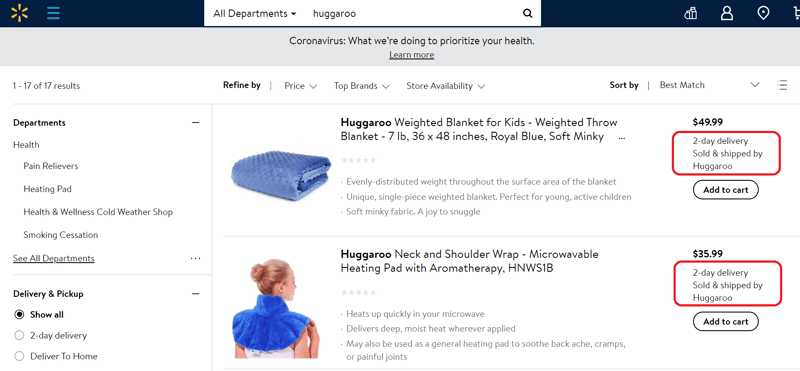
Your inventory is business-critical. No inventory equals no business. But, even with a warehouse full of stock and a sales channel full of listings, if you don’t have inventory and fulfillment efficiency, you can struggle to sell, ship, and earn that glowing feedback you deserve.
In this article, we’ll explain the importance of inventory efficiency, describe a strong fulfillment process for your business’ success, and how to take control of both.
What Is Inventory Efficiency?
Inventory efficiency refers to optimizing your stock levels and warehouse space to meet customer demand, without overstretching your operational overheads. It’s all about strategically placing your inventory to avoid selling out on one platform while having too much inventory on another.
Inventory and efficiency ensure you don’t have to rush to pull SKUs out of one network because your sales volume was unexpectedly high or low.
For example, say you have half your stock in Fulfillment by Amazon for your Amazon store, and the other half in Walmart Fulfillment Services for your Walmart store. Suddenly, your Walmart volume spikes unexpectedly and your Amazon volume has remained stagnant. You’re now sold out on Walmart but have too much stock in Amazon, accruing storage fees. You now have to rush to remove inventory from FBA to get it into Walmart to avoid going out of stock, which will affect your listing health.
What Is Fulfillment Efficiency?
Fulfillment efficiency is how quickly you handle stock, taking measures to minimize the time between order and delivery so you can ship as quickly as possible. It involves optimizing the entire fulfillment chain. This includes strategically located warehousing, seamless order management, and more.
Warehousing
Warehousing is how you physically store products until you sell and ship them to customers. It covers the receipt, storage, organization, and tracking of goods, and ranges from a garage through to a network of warehouses across the country.
As an example of optimized warehousing, Deliverr invests in a strategically placed warehouse network that’s close to historic demand. That means we’ll look at your item, predict demand, and try to get your inventory as close as possible to your future buyers to minimize the time it takes to get items delivered.
Order Management
Order management covers how you download orders from your online store or marketplaces, and direct them to the relevant warehouse and department for processing. For most online sellers, this involves using an order management tool or multi-channel management software. Try to find a listing tool that works across everywhere you sell, so that your orders and inventory stay synchronized in real time.
Picking and Packing
Picking and packing involve finding the products for an order and packaging them together ready for shipping. Depending on the size and location of your storage, this could be a quick trip to the spare room or a long ride into the back of a warehouse and then to a separate packing station. If you’re working with a fulfillment company you don’t have to worry about this, but you can still ask what that company is doing to optimize warehouse procedures.
Shipping
Finally, shipping covers how orders travel from your warehouse to your customers, including how quickly you print shipping labels, how long orders take to travel to their destination, and how reliable your chosen shipping carrier is at delivering products on time (and to the right door).
The Importance of Inventory and Fulfillment Efficiency
Together, inventory and fulfillment efficiency are powerful advantages for your business. Achieving peak efficiency benefits your sales, profits, and customers for a few main reasons.
1. Inventory Insight
Do you know what goes on in your warehouse, which products take the longest to find, which delivery locations are the most popular, and which items routinely fall out of stock?
Inventory efficiency requires detailed knowledge about your stock, gained from using inventory management software. This software allows you to view a central pool of your inventory and monitor overall performance in real-time, while also giving you the insights needed to grow your business.
For example, you can:
- Identify trends in demand to assist with inventory planning
- Highlight locational demand to aid strategic warehousing decisions
- Monitor shipping speeds to see how you can improve them
2. Customer Demand
Good inventory efficiency is holding enough stock in the right places, which means you always meet customer demand without selling out or overselling.
Holding enough stock to meet customer demand is crucial for driving your store sales, keeping customers away from your competitors, and creating a positive customer experience that results in repeat purchases and glowing reviews. It’s also essential for:
- Maintaining your search result position on online marketplaces
- Remaining eligible for marketplace fast shipping programs
- Avoiding late deliveries caused by stock-outs and backorders
3. Audience Reach
Fulfillment and inventory efficiency increase your audience reach, resulting in more conversions and higher profits.
Inventory efficiency involves disbursing your stock across a network of warehouses, so you hold products close to historical demand, allowing you to meet future demand. This disbursement of stock also means you increase the locations you deliver to, increasing your pool of customers.
Fulfillment efficiency increases the speed you deliver orders, allowing you to target the 95% of shoppers who view expedited delivery as very important when shopping online.
The more shoppers you appeal to, the more conversions you generate and positive reviews you receive, triggering a flywheel effect of continued growth.
4. Fast Shipping
Speaking of expedited deliveries, holding enough stock in the right places also fuels fast shipping speeds. The closer stock sits to customers, the quicker it is to deliver, allowing you to offer speeds of 2-day and next-day deliveries for the needs of your direct customers and online marketplaces.
A distributed warehouse network, coupled with fulfillment efficiencies that reduce how long an order takes from receipt to delivery, can produce shipping speeds that:
- Qualify you for fast shipping programs such as Walmart 2-day delivery and Wish 2-day, increasing your visibility and sales

(Source)
- Allow you to add fast shipping tags and banners to your website and marketing materials
- Meet the growing demand for faster shipping
Together, these work to increase your visibility, boost conversions, and multiply your profits.
5. Business Efficiencies
Finally, fulfillment and inventory efficiency increase your overall business efficiency.
Inventory efficiency reduces the admin time needed by using inventory management software to sync sales channel updates, complete stock takes, and record data.
Fulfillment efficiency reduces the labor involved with fulfillment by streamlining order receipt, picking, packing, and shipping.
And when you increase business efficiencies, you have more time, resources, and money to invest in business growth.
Tips for Improving Inventory and Fulfillment Efficiency
So, where do you begin improving fulfillment and inventory efficiency to benefit your business?
1. Market Demand
Knowing how much stock you need and how quickly customers expect orders is fundamental for improving efficiencies.
Use sales data, market research, and current buyer behavior to forecast product demand and understand delivery expectations. Then use this data to order stock and ship items accordingly. Depending on your supplier, you might need to negotiate their minimum order quantities (MOQs) so you’re not holding more stock than you can sell.
2. Inventory Management Software
Keeping track of your inventory and fulfillment data is necessary for processing orders quickly, analyzing previous performance, and identifying areas for improvement.
Inventory management software makes this task more efficient and accurate by doing the hard work for you. It gives you an overview of your central inventory pool, while also generating the detailed insights for strategically managing that pool.
Inventory management software also integrates and connects with your sales channels, automatically syncing stock levels and order updates.
3. Distributed Warehouse Locations
You lose a large proportion of fulfillment efficiency during the shipping process when transporting products from your warehouse to a customer’s doorstep.

(Source)
By distributing your inventory over a network of warehouse locations, your stock sits closer to your end customers and has less distance to travel. This distributed fulfillment strategy helps you ship quickly enough to meet sales channels and customer demand, while also increasing the number of locations you can sell in.
Bonus benefit: Deliverr uses disbursed warehouses to offer nearby customers next-day deliveries at no extra cost to our merchants. This can be a great marketing and conversion-boosting tactic for businesses, especially during the holidays.
4. Stock Distribution
How you distribute stock across and inside warehouses also influences efficiencies. For example, if you sell orange t-shirts and hold 80% of your stock in a New York warehouse, but most orders come from San Francisco, you’re losing a lot of time to shipping.
Likewise, if orange t-shirts are your most popular product, but you store them at the very back of your warehouse, you’re losing a lot of time to warehouse workers having to dig out those items.
An outsourced fulfillment partner uses intelligent technology to route your inventory according to historic demand and best picking practices. However, if you fulfill orders in-house, the ABC classification method can also help.
Using the ABC method, you purchase, disburse, and store your stock in the priority of:
- The 20% of SKUs contributing to 80% of revenue
- The 30% of SKUs contributing to 15% of revenue
- The 50% of SKUs contributing to 5% of revenue
It’s also worth noting that the entire layout of your warehouse can speed up or impede your fulfillment team. Ideally, you want a warehouse layout that reflects an order’s journey, so employees don’t waste time walking backward and forwards to download, pick, and pack orders.
5. Outsourced Fulfillment
If you struggle with inventory and fulfillment efficiencies in-house, an outsourced fulfillment partner can help. There are a few common choices for outsourced eCommerce fulfillment.
Marketplace Fulfillment
Many marketplaces have their own fulfillment networks, such as Fulfillment by Amazon. FBA is a popular fulfillment option for Amazon sellers, providing a network of warehouses alongside fast speeds of 2-day and next-day delivery.
While FBA serves Amazon sellers well, anyone selling beyond Amazon may get stung by their multi-channel fulfillment fees. Other unexpected FBA costs for online sellers include long-term storage, heavy items, and repackaging fees. Amazon multi-channel fulfillment is also not allowed on some sales channels, such as Walmart, due to their Amazon branding.
Marketplace-specific fulfillment providers either lean heavily towards their own marketplaces, or don’t support other channels at all. So you’ll end up sending inventory into multiple networks, especially if you’re a strong multi-channel seller.
Multi-Channel Fulfillment Partner
A multi-channel fulfillment partner offers an outsourced fulfillment service that’s more flexible and cost-effective for multi-channel or website-only sellers. The benefits of using an outsourced fulfillment partner include:
- A dispersed network of warehouses, allowing you to offer fast shipping country-wide, at an affordable price
- Flexible warehouse space that grows with your business or seasonal demands
- Simplified pricing that doesn’t leave you guessing at your margins
- Integration with your sales channels and order management systems to process and update orders as quickly as possible
Further reading: Key Considerations of Multi-Channel Fulfillment
What’s the difference between a fulfillment partner and 3PL?
A 3PL is an outsourced service provider that handles your eCommerce logistics for you. However, 3PLs tend to have fragmented processes, with different companies responsible for different stages of fulfillment. One company handles warehousing, another handles pick/pack, another handles shipping, and so on. And often, their processes aren’t time-sensitive, which is not ideal for eCommerce.
An outsourced fulfillment partner like Deliverr exists to serve and grow eCommerce businesses. They provide the logistics of a 3PL, but with the all-inclusive pricing, sales channel integrations, and fast shipping speeds necessary for eCommerce success.
How To Calculate Inventory and Fulfillment Efficiency
Calculating your inventory and fulfillment efficiency allows you to benchmark current performance and monitor improvements.
Calculating Inventory Efficiency
Inventory efficiency can be measured using your inventory turnover ratio and inventory conversion ratio:
Inventory turnover ratio = sales / average inventory*
* (inventory at the start of a period + (inventory at the end of a period) / 2)
Your inventory turnover ratio shows if you hold enough stock to meet customer demand without draining your operations budget. A low figure indicates you hold too much stock, and a high figure suggests you might not hold enough.
Inventory conversion period = average inventory / cost sold per day
Your inventory conversion ratio shows how many days it takes to sell products. For example, your cost of inventory is $40,000 and the amount of sales you make per day is $400. That means it’ll take 100 days to go through the inventory you have in stock now.
A high number indicates poor inventory efficiency (if it’s more than 365 you risk running into long-term storage fees), and a low number indicates you might be at risk of selling out.
Calculating Fulfillment Efficiency
Fulfillment efficiency can be measured using various KPIs, the most insightful being:
On-time shipping = orders shipped on time / total number of orders shipped
Order cycle time = time between order placement and receipt / total number of orders shipped
These calculations show how quickly you pick and pack orders, how often you ship orders on time, and how long customers have to wait for their order. The quicker you take, the more efficient your fulfillment operation is.
Tip: Use Deliverr for nationwide 2-day delivery. By outsourcing fulfillment, you free up your time to invest in growing the business instead of optimizing warehouses.
Conclusion
Inventory and fulfillment efficiency are fundamental to business growth. They ensure you meet and exceed customer expectations by always holding enough stock in the right places, and always delivering orders on time.
Even better, it doesn’t have to be hard or expensive to improve both.
- Look at sales data and market research to predict customer demand.
- Use inventory management software to monitor your inventory and highlight inefficiencies.
- Utilize a wide network of warehouse locations to reduce distance between stock and buyers.
- Distribute stock in strategic locations across the country and your warehouses.
- Outsource fulfillment if you’re struggling to improve efficiencies yourself, or you simply want the experts to handle it.





Leave a reply or comment below